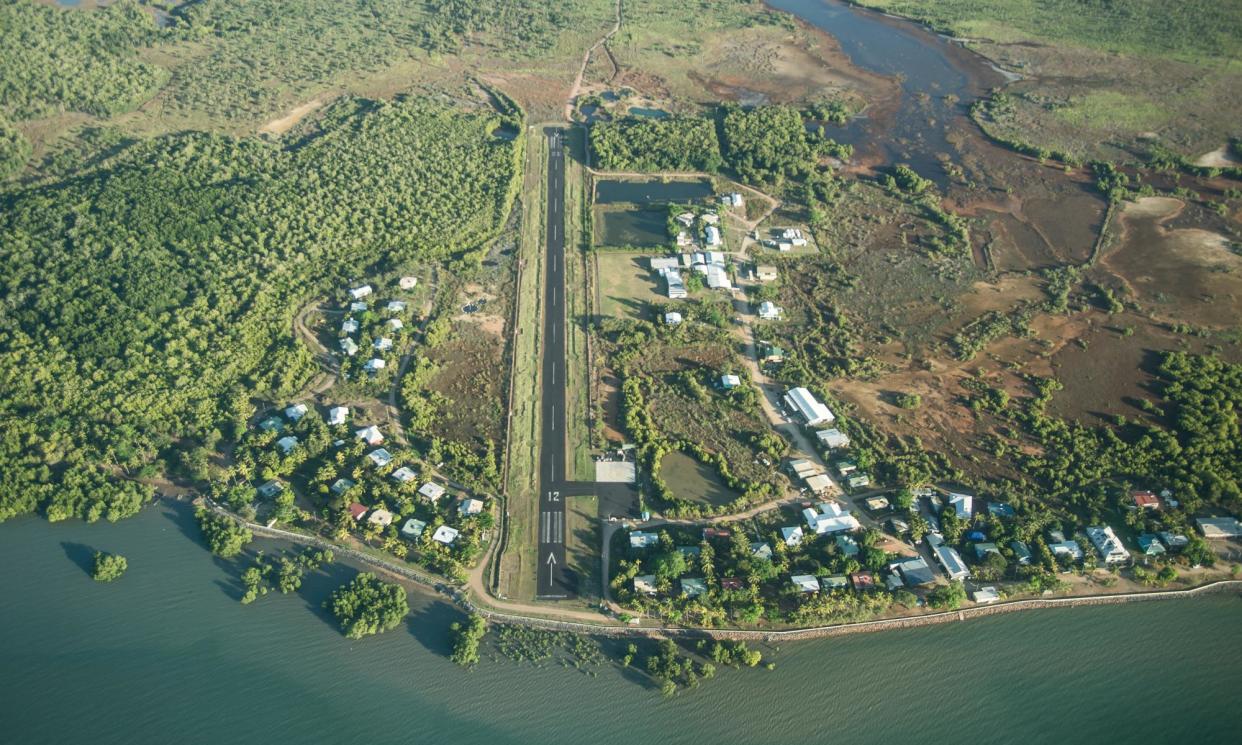Rwandans arrive in Australia after perilous journey to claim asylum

As the UK government continues its push to forcibly remove asylum seekers to Rwanda, a group of Rwandan nationals has claimed asylum in Australia after arriving by boat on a remote island.
The five men arrived in Australia by an unconventional route, reportedly flying into the Indonesian capital, Jakarta, to be granted visas on arrival, before travelling thousands of kilometres east to Indonesia’s Papua province, where they crossed the land border it shares with Papua New Guinea (PNG).
From PNG’s western province they took a dinghy to Saibai Island, one of Australia’s northernmost points: the tiny, low-level island is just 4km from PNG’s mainland in the Torres Strait.
Related: ‘Stop the boats’: Sunak’s anti-asylum slogan echoes Australia’s harsh policy
Travel across the strait is fluid. Papua New Guinean nationals in neighbouring coastal villages and Indigenous Australian islanders are allowed to move freely between the two countries for traditional activities, but outsiders are uncommon, and tend to be conspicuous. In 2017, six Chinese nationals were detected in the Torres strait, having travelled through PNG to Saibai Island. They were returned to China.
The five Rwandans were reported to have been found by local hunters in mangroves in an uninhabited part of Saibai, a known crocodile habitat.
The basis for the Rwandans’ asylum claim is unknown. They remain in the Torres strait, but unless PNG agrees to take them back with an undertaking they will not be returned to potential persecution they are likely to be transferred to Australia’s “offshore processing” detention centre on the Pacific island of Nauru.
The UK’s government’s effort to send people from small boat arrivals to Rwanda for processing and resettlement has been promoted as directly inspired by the Australian example of offshore processing. The home secretary, James Cleverly, told parliament in December that Australia’s boat arrivals had “trended pretty much down to zero – deterrence works”.
The UK Home Office has said it does not know whether the Rwanda plan will reduce boat crossings: a departmental impact assessment says it’s a “novel and untested scheme, and it is therefore uncertain what level of deterrence impact it will have”.
Jana Favero, from the Asylum Seeker Resource Centre in Melbourne, said the UK’s adoption of its Australian-inspired policy was “cruelty for cruelty’s sake”.
“It’s incredibly ironic that at the same time the UK is rounding up people to send them to Rwanda, there are reports of Rwandans arriving on Australia’s shores seeking asylum.
“And it is deeply disturbing that the UK is knowingly copying our offshore detention policy given the overwhelming evidence it is a failed policy.”
Australia has twice implemented offshore processing regimes: the most recent iteration has been plagued by scandal and has cost upwards of A$10bn (£5.5bn). At least 12 people have died in the camps, including being murdered by guards, through medical neglect and by suicide. Psychiatrists described camp conditions as “inherently toxic” and akin to torture.
The United Nations has repeatedly said Australia’s system violates the convention against torture, and the international criminal court’s prosecutor said indefinite detention offshore was “cruel, inhuman or degrading treatment”.
The detention centre on PNG’s Manus Island was ultimately ruled illegal by the PNG supreme court and ordered shut. Australia had to pay more than $70m in compensation to more than 1,000 people it had illegally incarcerated on the island.
Several thousand asylum seekers were also sent to Nauru, from where most have eventually been resettled in third countries including the US and New Zealand, often after years on the tiny remote island. Removals to Nauru restarted in 2023 and there are now 64 people held there.
Offshore processing alone did not “stop the boats”. In the first 12 months after the policy was reinstated in 2012, government figures reveal more people arrived by sea seeking asylum than at any time in Australian history. Within three months, Australia’s offshore processing centres were overfull, and the government had to stop sending people offshore.
But the arrival of boats on Australian shores has been dramatically slowed, largely through the intervention of Australia’s navy and border force physically intercepting the boats and forcing their occupants back to the countries they left.
Madeline Gleeson, senior research fellow at the Kaldor Centre for International Refugee Law at UNSW and the author of Offshore, said the Australian example was a “very close precedent” for the UK plan, “and it’s been shown not to work”.
“It’s likely to be a relatively small number who go to Rwanda – if any at all. The majority of people lodging asylum claims in the UK are likely to remain there, and for those who do have protection needs, the idea that this plan will deter them doesn’t stack up and is not borne out by Australian experience.”
In the debate over whether or not Rwanda is a “safe country”, she stressed the importance of individualised risk assessments.
“People can be displaced from any country, and a country which is safe for one person may not be safe for another. The better approach is to ensure timely access to efficient and fair asylum processing systems, so that we can establish who people are, the bases for their protection claims, and the most appropriate ways to connect them with durable solutions.”
The fate of the Rwandans who have arrived in Australia is as yet unclear. They remain on Saibai Island, and efforts to return them to PNG – under an existing protocol designed to deal with irregular migration in the Torres strait – appear not to have even begun.
PNG’s chief migration officer, Wellington Navasivu, said: “PNG has yet to receive any formal communication from Australia on this matter”, while the foreign affairs minister, Justin Tkatchenko, told the Guardian it was “news to me … this is the first I am hearing about this”.


